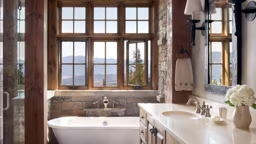
Photo Credit: Art3d
There are a lot of reasons to love open-concept floor plans, but the way sound carries from room to room isn’t one of them. And with more people being at home full-time these days, it’s more important than ever to find a little peace and quiet. How can you nullify the noise without sacrificing your expansive space? Follow these simple tips.
1. Log & timber head start.
Full-log homes have built-in soundproofing benefits because solid wood walls absorb sound better than a flat drywall, creating an ultra-quiet house.
In timber frame homes, the thick structural insulated panels (SIPs) offer an advantage of their own. “Typically used as a building’s exterior walls, our SIPs are manufactured by structurally laminating a continuous core of expanded polystyrene (EPS) insulation to two pieces of performance-rated oriented strand board (OSB),” explains Insulspan’s general manager Stephen Munn. “SIPs come in a variety of thicknesses, including many that are thicker than a standard 2-by-4 or 2-by-6 stick-framed wall. Because of this, SIPs can dampen and absorb noise, increasing owner comfort and creating, as one of our homeowners put it, ‘a sanctuary.’”
Post construction, you can take that sound transmission down another notch by adding shiplap; tongue-and-groove; leather or upholstered panels; or another sound-absorbing finishing treatment to the walls and ceiling.
2. Add knee-walls.
Since sound bounces off the nearest thing it comes in contact with, give it something to hit. Knee (half) walls are enough to keep everything from voices to footsteps from carrying; plus, they will give you extra display space for books or photos.
3. Hang window coverings.
No one wants to block the sweeping views that typically accompany log and timber homes, but large walls of glass will amplify the sound in a room. Curtains will help to absorb the sound waves and dampen the din. Go sheer so you don’t totally block the scenery, or, for maximum sound reduction, try a soundproofing curtain. The AcousticCurtain™ by Residential Acoustics claims to not only absorb but deflect sound waves away from a space.
4. Install solid-core interior doors.
Many budget-minded homebuyers opt for less-expensive hollow-core doors for their interior rooms, and though frugal, they do virtually nothing to block sound transmission. If you’re hoping to keep noise at bay, go for solid-core interior doors instead. They’re more expensive than hollow, but not as pricey as solid wood. They are heavy, so they’re more difficult for the DIYer to hang, but the extra heft is what makes them good at their job. A popular purchase: JELD-WEN® ProCore The Quiet Door®.
5. Go softer underfoot.
Though they are log and timber home staples, hard flooring materials, like tile and wood, are less than ideal for achieving a quiet space. Not into carpet? Consider alternatives like linoleum, which is a durable and practical finish in a kitchen, or luxury vinyl planks, which can give you the hardwood-floor look that reduces both sound and cost.
6. Minimize cabinets.
Open shelving is a trendy design choice, but did you know it also has an acoustical benefit? Since sound bounces of flat, hard surfaces, reducing the number of opportunities it has to echo will quiet the clamor. And it will save you a little coin on costly cabinetry, too.











